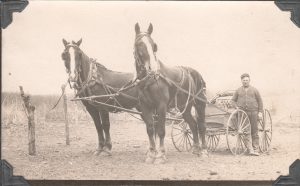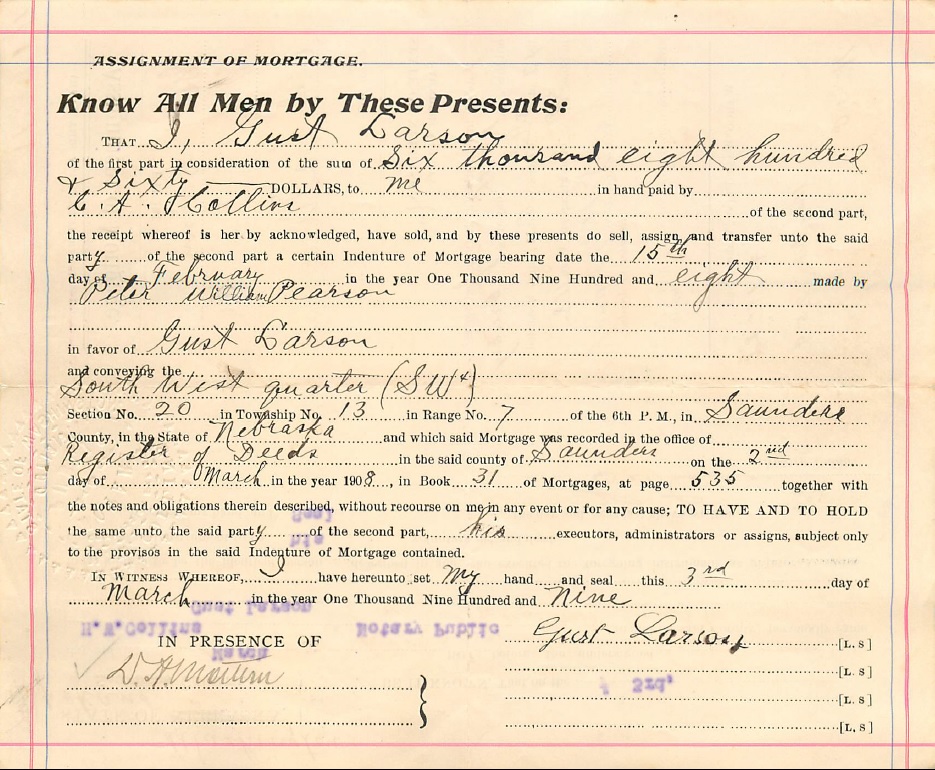
In previous posts on this topic, I’ve examined the will that he signed on February 2, 1920 and we recalled the letter written to the family by Pastor Granlund just the day before. I surmise that Will (P.W.) must have confided in his Pastor on Sunday, February 1 that he knew his illness was terminal and had asked Pastor Granlund to meet him in town the following day to witness his will.
Next we looked at the Petition for Probate, filed on September 15, 1920, which sort of laid out the family’s situation. The document stated that there were five heirs (Will’s wife Clara and their four children), and that Will owned some real estate and some personal effects (not itemized in this particular document).
We then examined the family’s farm operations and some candid photos from the mid-1910’s.
This time, we’ll take a closer look at the family’s financial situation prior to Will’s death, particularly the real estate situation. Next time we’ll look at some medical bills, and then after that we’ll resume an examination of the probate file.
Let’s refresh a bit about the land situation. In 1905 when Will and Clara returned to Nebraska from Wyoming, they leased the original Pearson homestead farm (in Chapman Precinct) from Christian and had a very formal rental agreement (I still think that’s really odd for the era). Will was supposed to inherit this farm when Christian died, but would have to pay his siblings $1,500 – presumably to even things out so that everyone inherited equally. Things didn’t actually get settled that way, because I think Will may have purchased that farm from Christian outright prior to Christian’s death. I can’t know for certain without studying the land records in the Saunders County courthouse.
By the time of the 1916 atlas, Will had sold the homestead farm and had purchased a 160-acre farm just north of Ceresco, which is still in the family to this day. A Warranty Deed shows that it was purchased from Gust and Ada Larson on November 14, 1907 for the price of $6,000. The family took possession on March 1, 1908. The Larsons had mortgaged the farm. The lender was a C.A. Collins of Spokane, Washington. This mortgage was assigned to Will. Subsequently, Will and Clara then mortgaged the farm for $8,000 with money lent from the Larsons. I’m really not sure how all this mortgage financing worked back in these days. It looks like all the agreements are between private parties, and the loan terms are typically just five years. I think in the end, Will and Clara did some sort of cash-back scheme where Collins was paid off, $1000 went to the Larsons, and Will and Clara may have used the other $1000 for improvements.

That mortgage would have been due in 1913. In February 1913, Will and Clara borrowed against the farm again, this time from Mrs. Elvira Putney of Wahoo. The loan amount is again $8,000. A little bit of googling shows that Mrs. Putney’s late husband George was an early Saunders County pioneer. His widow apparently invested her wealth in the local real estate mortgage market. The Citizens State Bank of Wahoo handled all the details and may have even brokered the deal. Again, I’m not real clear on how this private mortgage business worked back in these days.
In February 1918, they “refinanced” – again borrowing $8000 from Mrs. Elvira Putney with 5 1/2 percent interest due annually and the principal due in a lump sum in 1923.
The point of all this is that the family did not own their farm outright and they appear to have been securing one mortgage after another – making the interest payments but never making any headway on the principal.
The period between 1910 and 1920 is widely considered to be the “Golden Age of Agriculture”. Farmers were getting great prices on their crops and were able to take their profits and buy mechanized equipment and more land. It’s a little puzzling, therefore, that Will and Clara did not get their land paid off during this time. Maybe they weren’t worried about it and were using all the farm profits to make improvements and invest in the Poland China herd. The photos from last time show a lot of building going on and a new well being drilled. I show the picture of Will’s brother, Carl Oscar, and his magnificent pair of horses on this page just to illustrate the kind of success and pride that the Pearson families had during this prosperous time (click on the photo above to enlarge it – it is really quite an impressive team of horses, they’re HUGE!).
Had they known Will’s fate and the coming downturn in the agricultural economy, they surely would have made different choices. The mortgage on the farm would haunt this family for decades to come.
